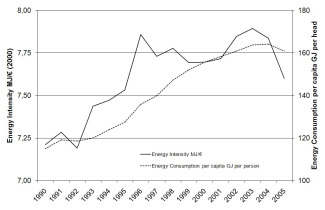Energy and development in Catalonia: an inadequate model of growth

In the coming years, Catalonia will suffer an increase in energy prices, which will deal a heavy economic blow given its since it has an energy dependency rate of 98%. The work led by Jesus Ramos of Universitat Autònoma de Barcelona analyzes the energy sectors in Catalonia and their efficiency. The outcomes indicate that the reduction of energy consumption is not viable in the policy framework and Catalonia's development model is inefficient; immigration virtues also can become a disadvantage in medium-term if the growth model is not radically changed.
This article makes an analysis of how Catalonia has been using energy in the period 1990-2005. Knowing the use an economy makes of energy is relevant not only from an environmental point of view (due to the greenhouse gas emissions associated), but also from an strictly economic point of view (due to the increasing cost of energy). This is particularly relevant for Catalonia since it has an energy dependency rate of 98% (if we take into account that the fuel for nuclear plants is also imported). This dependency, along with the increasing relative scarcity of energy sources (mainly oil) due to what is know as Peak Oil (having reached the maximum oil extraction possible), will drive energy prices up in the near future, hitting more those economies such as Catalonia that are heavily dependant on imports for its energy consumption.
In this context it is important to know in which sectors Catalonia uses energy and which is the efficiency of its use, that is, how much added value is generated with its use. This is what this article explores for the given period of time and for different economic sectors.
The first result observed is the high correlation between GDP growth and energy consumption. This is bad news from an environmental point of view, since it implies that a reduction in energy consumption will imply a decrease in GDP, something that no politician will support. The alternative would be a shift in economic structure, away from our dependence in the transport sector (where emissions are increasing faster than the average).
A second result shows better one of the weaknesses of the development model in Catalonia. Instead of reducing the energy needed to produce one euro of added value (what is known as energy intensity), Catalonia needs more energy to produce the same. And this is coupled with an increase in energy consumption per capita, as it can be seen in the Figure.
A third major result is that, thanks to the massive entrance of immigrants at working age, Catalonia has escaped a necessary restructuring of the economy. That is, local population is ageing. This would require that the current lower labour force increases its productivity to cover dependent population. This problem was avoided thanks to immigration, since most of the immigrants are still in working age. However, this poses a problem for the near future. When the new immigrants get older, or they bring their families, Catalonia will need to increase its productivity. This leads to the third major result.
The fourth result is the link between productivity gains and energy consumption at work. One can see from our data that the stagnation in economic productivity of labour (in euro per hour of work) is due to the stagnation in the energy consumption per hour of work.
Combining these outcomes, the situation is difficult for countries such as Catalonia that are very dependent in energy sources from overseas, that have an ageing population, and a high dependence on the transport sector. Therefore, “doing more of the same” should not be an option, and we should think carefully how to change the development model, or we will have to face a dire future.
References
"Catalonia's energy metabolism: using the MuSIASEM approach at different scales". Ramos-Martín, J., Cañellas-Boltà, S., Giampietro, M., Gamboa, G. (2009): Energy Policy, Vol. 37 (11): 4658-4671.


